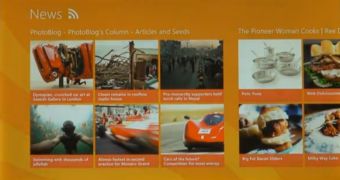HTML5 support is one way in which Windows 8 will bring its users closer to the Cloud, at least from the details that Microsoft shared so far on the forthcoming operating system.
Julie Larson-Green, Corporate Vice President, Windows Experience revealed that applications in Windows 8 will leverage the power of HTML5 in order to bring next generation user experiences to customers.
Essentially, since the term “Immersive” has been used to describe a range of aspects synonymous with the evolution to Windows 7, these apps will be exactly that, immersive.
“Today, we also talked a bit about how developers will build apps for the new system. Windows 8 apps use the power of HTML5, tapping into the native capabilities of Windows using standard JavaScript and HTML to deliver new kinds of experiences,” Larson-Green stated.
“These new Windows 8 apps are full-screen and touch-optimized, and they easily integrate with the capabilities of the new Windows user interface. There’s much more to the platform, capabilities and tools than we showed today.”
Have a look at the video embedded below, the official Windows 8 preview that Microsoft made available to the public today.
In the first part, Jensen Harris, Director of PM Windows User Experience talks about this specific part of the Windows 8 evolution.
He notes that Microsoft built a new development platform in Windows 8, designed specifically to appeal to web developers, especially those leveraging Html5, JavaScript and CSS.
I for one welcome this, but I cannot help but ask, what about Silverlight? Where do Silverlight 5 and Silverlight 6 (if Microsoft will even get to this one) fit into the Redmond company’s strategy for developers?
In fact, does Silverlight even have a place in the software giant’s vision for next generation Windows 8 applications? The technology is certainly supported today on platforms such as Windows Phone 7 and Windows 7, but I wonder whether Silverlight will survive once Microsoft opens up Windows 8 and Windows Phone 8 to HTML5 and JS.
Here is how Lee Stott, Academic Evangelist at Microsoft UK, responsible for Faculty Connection and MSDNAA within the UK describes the Windows 8 applications:
“Windows 8 will focus on two types of apps:
• Classic Windows desktop apps- they will run and look similar to Win 7 today. They will open from the Start screen into familiar Win 7.
• HTML5/Javascript apps – they will look more like mobile apps and will run in a different experience than classic Windows apps. This includes IE10. This new style of app will be able to access everything new in Windows 8.
The concept of HTML 5 application is these be like mobile apps and will run in a different experience than classic Windows applications additionally HTML 5 applications will have access to a number of new features in Windows 8 and both type native windows and HTML 5 applications can run side by side.
Apps using “new Windows” programming are built in HTML and Javascript. Windows 8 will run both those apps and ones written in traditional Windows code.”

 14 DAY TRIAL //
14 DAY TRIAL //